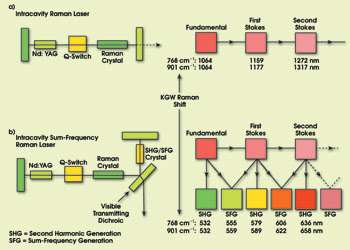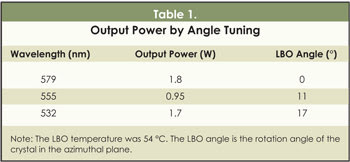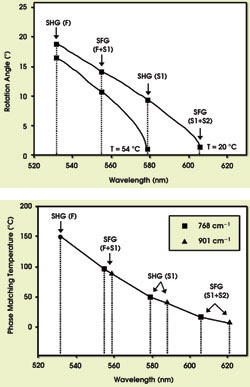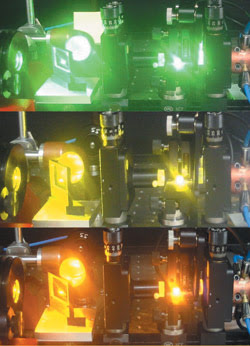Raman lasers with intracavity nonlinear optics are promising alternatives to multiline lasers and parametric oscillators.
Richard P. Mildren, Helen M. Pask and James A. Piper, Macquarie University
Have you ever wanted to convert your laser to another color at the flick of a switch?
Perhaps you are a dermatologist, wanting to quickly move from treating spider veins on the nose to acne or spots of hypopigmentation on sun-damaged cheeks. The ability to change the laser from hemoglobin-absorbing yellow to melanin-absorbing green and thence to the red for photodynamic therapy would reduce treatment time and enhance treatment selectivity.
In fact, a host of applications in biomedicine, remote sensing and defense would benefit from such an ability to switch wavelength rapidly. All-solid-state Raman lasers offer a practical means to do so.
Solid-state Raman lasers have emerged in recent years as powerful and efficient sources in spectral zones such as the yellow and orange that are difficult to access using conventional laser transitions. Output powers exceeding 1.5 W at 579 nm (the peak of oxyhemoglobin absorption) with pump-diode-to-visible efficiencies approaching 10 percent have been reported for compact diode end-pumped systems.1 The method uses Raman and sum-frequency media placed within the cavity of an Nd:YAG laser, taking advantage of the high intracavity field to enhance frequency conversion.
Flexibility and efficiency
The concept for these systems originates in the pioneering work of E.O. Ammann, who, in 1979, reported an arc-lamp-pumped intracavity Raman laser based on LiIO3.2 The crystal has substantial second- and third-order nonlinear susceptibilities and, when oriented appropriately, acts as the Raman and sum-frequency-mixing medium. Ammann demonstrated selectable output at five wavelengths ranging between 540 and 655 nm with output powers of up to 600 mW by changing the angle of the LiIO3 crystal.
The wavelength versatility stems from the possible harmonic combinations of the fundamental and Stokes optical fields. In a high-Q Raman resonator, the growth in the fundamental and the subsequent buildup of the Stokes fields occur rapidly and with a conversion efficiency approaching the Stokes quantum efficiency (~90 percent). By adjusting the phase-matching conditions in an intracavity nonlinear medium, visible output at selected second harmonics or sum frequencies can be extracted from the resonator (Figure 1a). Provided the harmonic conversion to the visible prevails over higher-order Stokes generation, the laser remains highly efficient for each selected output wavelength.

Figure 1. Schematics illustrate the layout of the intracavity Raman laser (a) and intracavity sum-frequency Raman laser (b). Also shown are the flow diagrams of efficient energy transfer and the wavelengths obtainable from harmonic combinations of the fundamental and first two Stokes orders for each design.
The combination of flexibility and intrinsic efficiency of this approach is unmatched by alternatives that use multiple neodymium lines or optical parametric generation. The typical Stokes shift of most solid-state Raman materials — 700 to 1000 cm–1 — allows the generation of up to five or six wavelengths that span the 532- to 600-nm spectral region. Because stimulated Raman scattering does not require phase matching, conversion efficiencies are not limited by angular acceptance, back-conversion and walk-off. As a result, photon conversion efficiencies approach unity, and overall system efficiencies are typically much higher than optical parametric oscillator systems. In addition, the spectral linewidth remains similar to the neodymium drive laser without requiring the introduction of line-narrowing elements.
Higher powers
Our recent research has centered on increasing the output power of the Raman lasers into the multiwatt regime, which is of importance for many medical and defense applications. Achieving this requires a consideration of the resonator spatial-mode dynamics in the presence of a thermal lens formed in the Raman medium, as well as the thermal lens in the laser medium.
Our early work on LiIO3 Raman lasers had led to more than 1 W of output power at 578 nm by using a nonlinear mixing crystal made of lithium triborate and an Nd:YAG gain medium.3 The resonator was designed to optimize the mode sizes in the Raman crystal and the nonlinear frequency-mixing medium at maximum pump power.
Combining a resonator design that accommodates dynamic thermal lensing with variable phase-matching conditions has enabled us to demonstrate more-powerful wavelength-agile lasers.
One such intracavity sum-frequency Raman laser was end-pumped by up to 23 W of 808-nm radiation from a fiber-coupled diode laser. The resonator, typically 25 cm long, was defined by the coated plane face of the Nd:YAG laser crystal, a plane dichroic mirror at 45° and an end mirror broadband reflector with a radius of curvature of 200 mm (Figure 1b). The dichroic output coupler was highly reflecting from 1064 to 1170 nm and highly transmitting in the visible. The laser was acousto-optically Q-switched at a repetition rate of about 16 kHz.
We selected the Raman material potassium gadolinium tungstate (KGW) for its excellent thermal properties and because it offers the additional flexibility of two high-gain Raman modes.4 For a KGW crystal, the dominant Raman mode is 768 cm–1 when the optical Nm-axis is parallel to the polarization of the fundamental resonator field. For a 1064-nm fundamental drive, the resulting first and second Stokes wavelengths are 1159 and 1272 nm, respectively. By rotating the crystal 90° with respect to the fundamental polarization, the dominant mode becomes 901 cm–1, and the first and second Stokes are 1177 and 1317 nm. As a result, seven wavelengths spanning the green to the red can be generated from the harmonic combinations of the first and second Stokes wavelengths.
Harmonic generation and wavelength selection were achieved by angle and temperature tuning of lithium triborate (LBO) inside the resonator. We selected LBO as the nonlinear medium over alternatives such as beta-barium borate, potassium titanyl phosphate or quasi-phase-matched crystals because it can be easily configured for either angle or temperature tuning as well as for providing efficient conversion to the visible.
 For angle tuning, we used a 10-mm-long piece of LBO cut for type-I noncritical phase matching (i.e., θ = 90°, f = 0°) and antireflection-coated for the 1064-nm fundamental. Table 1 summarizes the laser’s performance at 54 °C, the temperature for noncritical phase matching at 579 nm at normal incidence. At 23 W of incident diode pump power (which corresponds to ~20 W of absorbed pump power), we obtained 1.8 W of 579-nm light, for a diode-to-yellow optical conversion efficiency of 8 percent. With the diode pump laser operating and the crystal tilted by approximately 10° (external angle), 0.95 W of output power was generated at 555 nm by sum-frequency generation of the fundamental and first Stokes. Increasing the angle to 17° generated 1.7 W at 532 nm — the second harmonic of the fundamental.
For angle tuning, we used a 10-mm-long piece of LBO cut for type-I noncritical phase matching (i.e., θ = 90°, f = 0°) and antireflection-coated for the 1064-nm fundamental. Table 1 summarizes the laser’s performance at 54 °C, the temperature for noncritical phase matching at 579 nm at normal incidence. At 23 W of incident diode pump power (which corresponds to ~20 W of absorbed pump power), we obtained 1.8 W of 579-nm light, for a diode-to-yellow optical conversion efficiency of 8 percent. With the diode pump laser operating and the crystal tilted by approximately 10° (external angle), 0.95 W of output power was generated at 555 nm by sum-frequency generation of the fundamental and first Stokes. Increasing the angle to 17° generated 1.7 W at 532 nm — the second harmonic of the fundamental.
The laser’s performance is highly stable. Our initial lifetime tests have demonstrated stable output power (<10 percent fluctuation) over tens of hours.
As mentioned, we chose to operate the laser at 54 °C to maximize the output in the yellow, but lowering the LBO temperature enables four or more wavelengths to be scanned for a similar range of angles. At 20 °C, noncritical phase matching for sum-frequency generation of the first and second Stokes at 606 nm is achieved, and four wavelengths can be scanned for less than an 18° rotation of the beam axis in the crystal (Figure 2a).

Figure 2. The calculated phase match angles (top) and temperatures (bottom) for second harmonic generation (SHG) and sum-frequency generation (SFG) of fundamental and Stokes fields in LBO were produced using SNLO nonlinear optics code, available from Arlee V. Smith of Sandia National Laboratories in Albuquerque, N.M. F = 1064-nm fundamental; S1 = first Stokes; S2 = second Stokes.
It is desirable to use small rotation angles, which minimize reflection losses, and to avoid using wide-aperture crystals, which have a larger volume and thus are more expensive. By using BBO as the nonlinear medium, the four wavelengths may be accessed within a 3° rotation.
Temperature tuning is very attractive because realignment of the resonator when switching wavelengths can be avoided and the crystal can be aligned normal to the resonator axis where the insertion losses are minimal. Also, for LBO, excellent alignment stability can be achieved as noncritical phase matching occurs near room temperature.
The wavelength dependence on phase-matching temperature in LBO provides switching among 555, 579 and 606 nm over a fairly modest temperature range (<100 °C) at fixed angle (Figure 2b). Phase matching is also achieved for 532 nm by increasing its temperature to ~150 °C; however, the extended temperature range increases the switching time and precludes the use of single-stage Peltier thermoelectric heating and cooling.
To overcome this limitation, we employed a novel method for wavelength switching across the four wavelengths (532, 555, 579 and 606 nm) that needed only modest temperature changes (<50 °C) by adding a second LBO crystal, identical to the other in size but cut for second harmonic generation of 1064 nm at 25 °C.
 Output at 532 nm with an average power of up to 1.5 W was achieved by adjusting the temperature of the second crystal (LBO2) to 25 °C (Table 2). Note that the temperature setting of the other LBO crystal (LBO1) is not important under these conditions because efficient frequency doubling depletes the fundamental, effectively forestalling conversion to the first Stokes. Switching to 555 nm was achieved by adjusting the temperature of LBO1 to 95 °C, the phase-matching temperature for sum-frequency generation of 1064 and 1159 nm, and by preventing phase matching in LBO2 by heating it to 52 °C. This allows the fundamental field to increase to the intensities needed for efficient conversion to the first Stokes.
Output at 532 nm with an average power of up to 1.5 W was achieved by adjusting the temperature of the second crystal (LBO2) to 25 °C (Table 2). Note that the temperature setting of the other LBO crystal (LBO1) is not important under these conditions because efficient frequency doubling depletes the fundamental, effectively forestalling conversion to the first Stokes. Switching to 555 nm was achieved by adjusting the temperature of LBO1 to 95 °C, the phase-matching temperature for sum-frequency generation of 1064 and 1159 nm, and by preventing phase matching in LBO2 by heating it to 52 °C. This allows the fundamental field to increase to the intensities needed for efficient conversion to the first Stokes.
Sum-frequency generation of 1064 and 1159 nm in LBO1 resulted in 0.52 W at 555 nm. To generate 579 nm, the LBO1 temperature was set for second-harmonic generation of 1159 nm (48 °C), and for 606 nm, it was set for sum-frequency generation of the first and second Stokes (19 °C). Output powers of 0.6 and 0.25 W were generated at these wavelengths, respectively.

Figure 3. The output wavelength can be rapidly switched, benefiting a host of applications. From top, the Raman laser here operates at 532, 579 and 588 nm.
We demonstrated temperature-tuned switching times of about one minute, which is suitable in the context of most medical treatments. The switching time is limited by the thermal response time of the LBO crystal and its mounting, and could be reduced to less than 30 seconds with improved thermal management.
In comparison with the angle-tuned results, lower output powers are obtained because of the additional insertion loss of the second LBO crystal and the effect of the longer resonator length on the pump-resonator mode overlap in the Nd:YAG rod.
We believe that these drawbacks will be overcome with improvements in the design, such as making the resonator more compact and reducing surface losses. For 606-nm output, the problem of relatively low output power is exacerbated by significant coating losses at 1272 nm. Improved coating selections are likely to see substantial powers at 606 nm and also longer wavelengths in the red corresponding to second harmonic generation and to sum-frequency generation of second and third Stokes orders.
Versatility
The intracavity sum-frequency Raman concept described here forms the basis of a highly versatile laser system spanning the spectrum from the green through the red and into the infrared. The system benefits from the excellent properties of the Raman material KGW, including the additional diversity of wavelengths provided by its dual Raman mode properties. KGW (and its analogue KYW) can be doped with neodymium and thus has substantial potential for laser miniaturization using “self-Raman” designs. (Note, however, that scaling to higher powers is more difficult because of the compounded heat load in the Nd:KGW arising from the Raman and fundamental laser processes, and because of the reduced freedom in engineering the mode sizes in the Raman medium.)
With these properties and the ability to rapidly switch the output wavelength, we envisage intracavity sum-frequency Raman lasers as highly practical sources suited to applications that benefit from targeting multiple photosensitizers, such as the treatment of skin disorders.
References
1. R.P. Mildren et al (2005). Wavelength-versatile green-yellow-red laser. Proc. Advanced Solid State Lasers and Photonics, WA5.
2. E.O. Ammann (June 15, 1979). Simultaneous stimulated Raman scattering and optical frequency mixing in lithium iodate. APPL. PHYS. LETT., pp. 838-840.
3. H.M. Pask and J.A. Piper (November 1999). Efficient all-solid-state yellow laser source producing 1.2-W average power. OPT. LETT., pp. 1490-1492.
4. I.V. Mochalov (June 1997). Laser and nonlinear properties of the potassium gadolinium tungstate laser crystal KGd(WO4)2:Nd3+ — (KGW:Nd). OPT. ENG., pp. 1660-1669.
Meet the authors
Richard P. Mildren (e-mail: [email protected]), Helen M. Pask (e-mail: [email protected]) and James A. Piper (e-mail: [email protected]) are researchers at the Centre for Lasers and Applications at Macquarie University in Sydney, Australia. They also are involved in a spin-off, Lighthouse Technologies Pty Ltd., that aims to commercialize wavelength-versatile lasers.